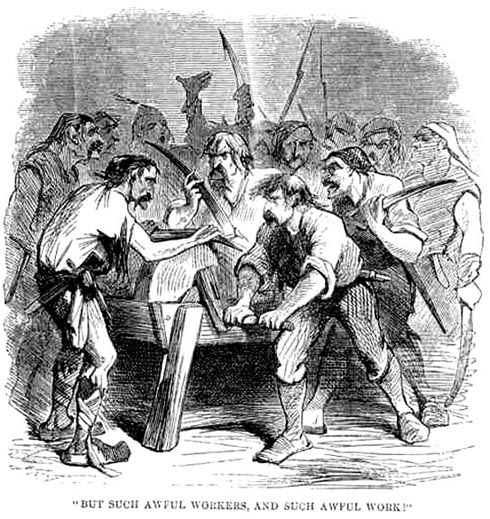
"But such awful workers, and such awful work!"
John McLenan
Dickens's A Tale of Two Cities, Book III, Ch. 2 ("The Grindstone")
The twenty-first installment of the novel appeared in Harper's Weekly (1 October 1859): 637.; it had originally appeared in the UK on Saturday, 24 September in All the Year Round
[See below for passage illustrated]
Scanned image by Philip V. Allingham; text by PVA and George P. Landow.
[You may use this image without prior permission for any scholarly or educational purpose as long as you (1) credit the person who scanned the image and (2) link your document to this URL in a web document or cite the Victorian Web in a print one. .]
Passage Illustrated
The people in possession of the house had let them in at the gate, and they had rushed in to work at the grindstone; it had evidently been set up there for their purpose, as in a convenient and retired spot.
But, such awful workers, and such awful work!
The grindstone had a double handle, and, turning at it madly were two men, whose faces, as their long hair flapped back when the whirlings of the grindstone brought their faces up, were more horrible and cruel than the visages of the wildest savages in their most barbarous disguise. False eyebrows and false moustaches were stuck upon them, and their hideous countenances were all bloody and sweaty, and all awry with howling, and all staring and glaring with beastly excitement and want of sleep. As these ruffians turned and turned, their matted locks now flung forward over their eyes, now flung backward over their necks, some women held wine to their mouths that they might drink; and what with dropping blood, and what with dropping wine, and what with the stream of sparks struck out of the stone, all their wicked atmosphere seemed gore and fire. The eye could not detect one creature in the group free from the smear of blood. Shouldering one another to get next at the sharpening-stone, were men stripped to the waist, with the stain all over their limbs and bodies; men in all sorts of rags, with the stain upon those rags; men devilishly set off with spoils of women's lace and silk and ribbon, with the stain dyeing those trifles through and through. Hatchets, knives, bayonets, swords, all brought to be sharpened, were all red with it. Some of the hacked swords were tied to the wrists of those who carried them, with strips of linen and fragments of dress: ligatures various in kind, but all deep of the one colour. And as the frantic wielders of these weapons snatched them from the stream of sparks and tore away into the streets, the same red hue was red in their frenzied eyes;--eyes which any unbrutalised beholder would have given twenty years of life, to petrify with a well-directed gun.
References
Dickens, Charles. A Tale of Two Cities: A story of the French Revolution. Project Gutenberg e-text by Judith Boss, Omaha, Nebraska. Release Date: September 25, 2004 [EBook #98].
Victorian
Web
Illus-
tration
A. W.
Bayes
A Tale of
Two Cities
John
McLenan
Next
Last modified 25 November 2007